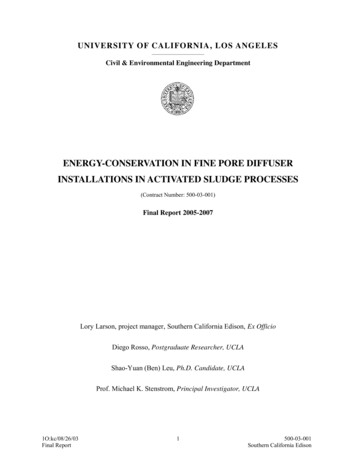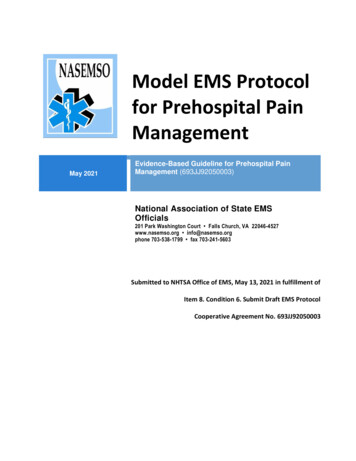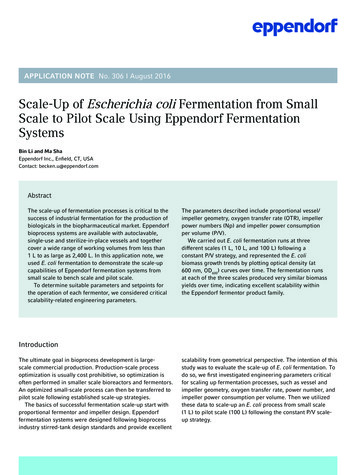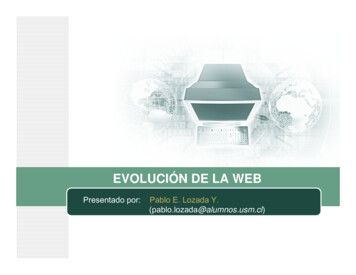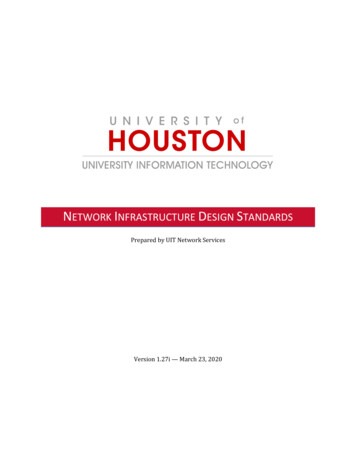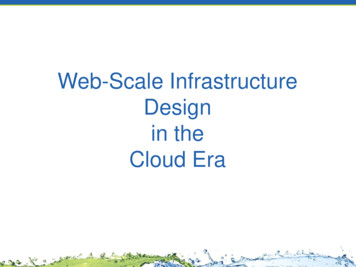
Transcription
Web-Scale InfrastructureDesignin theCloud Era1
AgendaIntroductionSustainable Data Center PracticesUsage Patterns Driving Architecture in the Cloud EraThe Software Defined DataCenterThree-Tier Architecture, Virtualization, Storage & SDNWeb-Scale IT2
IntroductionsJeff Renard (MCSE, VCP 4\5, VCP-DT, IEEE) is a technologist with 18 years ofexperience in virtualization, storage and infrastructure support & design. From his start as adot-com era consultant through user and systems support to roles at VMware andNutanix, Jeff has worked at all levels of the modern IT landscape. Jeff has helped Fortune500 Enterprises, Universities, Media Companies, State Governments and small businessesmodernize, streamline and better understand their IT operations. Jeff can be reachedat jrenard@nutanix.com or on Twitter @jeffreyrenardNutanix delivers web-scale IT infrastructure to medium and large enterprises with itssoftware-driven Virtual Computing Platform, natively converging compute and storage intoa single solution to drive unprecedented simplicity in the data center. The second fastestgrowing infrastructure company in Silicon Valley history & winner of multiple technology,platform and customer service awards, Nutanix is the blueprint for green, applicationoptimized and policy-driven infrastructure. Learn more at www.nutanix.com or follow upon Twitter @nutanix.3
FCOEInefficient SilosNetworkingLACP IP Addresses CIFSLUNsFibre AC AddressesServersNFSVT-XIPMIBIOS x86SMBEthernetInherent ComplexityDNSOSPFVLANStorageEnterprise Datacenters Are Too ComplexiSCSIRAIDZones4
Modern Data Center Pressures OpportunitiesReduce CostsMitigate Risk Reduce Energy Demands Create resource efficiencies Increase Utilization Respond to Regulation Enable supply chaintransparency Manage environmentalcomplianceGrow ShareSocial Responsibility Develop green products \services Be More Competitive on aGlobal Scale Improve Brand Identity Responsible environmentalstewardshipSource: a-center-sustainability.aspx5
Gartner - Information and Communications Technology Industryaccount for approximately 2% of global carbon dioxide emissions California Energy Costs could jump 47% over the next 15 years1 “Based on a mid-range estimate, the world’s Information-CommunicationsTechnologies (ICT) ecosystem uses about 1,500 TWh of electricity annually,equal to all of the electric generation of Japan and Germany combines – asmuch electricity as was used for global illumination in 1985. The ICTecosystem now approaches 10% of world electricity generation. Or in otherenergy terms – the zettabyte era already uses about 50% more energy thanglobal aviation” – Mark Mills, “The Cloud Begins With Coal” 08/20131. 0140426-story.html#page 16
Data Center EvolutionDistributedWorkloadsDistributed ComputeCOMPUTEVMVMVMVMVMVMVMVMVMVMVMVM STORAGE Converged Single point ofmanagement InflexibleArray Silo’d infrastructure Complex management High CapEx and OpEx19902000’s Converged compute storageEasy to scale and managePay as you grow economicsSupports all virtual workloads2010 7
Defining Cloud ComputingorCharacteristicsService ModelsDeployment Model On Demand Self-Service Broad Network Access Resource Pooling Rapid Elasticity Measured Service Software as a Service (SaaS) Infrastructure as a Service (IaaS) Platform as a Service (PaaS) Private Cloud Community Cloud Public Cloud Hybrid CloudSource: /SP800-145.pdf8
The Role of Virtualization Decommissioning a single 1U rackserver can save 500 /yr in energyand 1500 in hardware maintenancecosts1HypervisorX86 Architecture Reduce 54 VMs to 8 servers2 22,000 in annual energysavings 20 kW Reduction in energyannually 35 Servers Virtualized 130,000 in reduced 3-yearTCO related to “indirect costs”like power, cooling, provisioningtime and procurement31.2.3.Important to Recognize the Dramatic Improvement in Data Center Efficiency, Uptime Institute, er-efficiency/University of California, Santa Cruz Server Virtualization, Green Building Research Center Best Practices Case Study,2007. greenbuildings.berkeley.edu/pdfs/bp2007 ucsc virtualization.pdfImplementing Server Virtualization at Southwestern Illinois College, by Christine Leja, resmgr/research/swicserver-virtualization-c.pdf9
Software-defined Data CentersCompute, Network, Storage converged in x86 serversPaul Maritz, VMware’s chief executive, predicts that nearly all of thehardware in current computer rooms will e replaced by software runningon commodity-style servers. “This whole sea change of the softwaredefined data center is really starting to play out in earnest,”he said in an interview Monday.10NUTANIX INC. – CONFIDENTIAL AND PROPRIETARY
What is a Software Defined Data Center (SDDC)?ApplicationsSoftware pplication Consumption54DesktopInternetVirtual DesktopLaptopTabletMobile1Location Independence11
The Network is a Barrier to Software Defined Data CenterSoftware Defined Data CenterVDCProvisioning is slowPlacement and Mobility are limitedHardware dependent servicesSOFTWARE-DEFINEDDATACENTER SERVICESOperationally intensiveCompute Virtualization Abstraction LayerPhysicalInfrastructure12
The Solution: Transform the Network with VirtualizationSoftware Defined Data CenterVDCProgrammatic provisioningRun any workload anywhereDecouple services from hardwareSOFTWARE-DEFINEDDATACENTER SERVICESOperationally efficientNetwork Virtualization Abstraction LayerCompute Virtualization Abstraction LayerPhysicalInfrastructure13
The Role of Changing StorageHuge Opportunity for Cost and Power Reduction Enterprises Spend 12-25 Percent of ITBudgets on Data Storage1 Big Data, Unstructured Data & Virtualization Backup Strategies, Replication, DR The Emerging Role of FlashThe Zetabyte Era“The entire written works of man, from the dawn of time until today, in every singlelanguage, is the equivalent of 50 petabytes of data. Inside this one cage [at SuperNAP 7] is alittle over 100 petabytes” – Missy Young, Switch“The largest [GFS] cluster to date provides hundreds of terabytes of storage acrossthousands of disks on over a thousand machines, and it is concurrently accessed byhundreds of clients.” - http://research.google.com/archive/gfs.html1. avisite-study14
Emerging Storage Types15
Unstructured StorageThe vast majority of storage is never used againApproaching 35 Zetabytes by 20201- That’s 40 Trillion Gigabytes- All Data on Earth doubling every two 988/World s data will grow by 50X in next decade IDC study predicts 16
Big DataNew Data SetsNew ToolkitsNew Value Streams“As of 2012, exabytes of data were a reasonable data stream for processing1”(1)Francis, Matthew (2012-04-02). "Future telescope array drives development of exabyte processing". Retrieved 2012-10-24.17
Enabling TechnologiesWhat industry developments are enabling storage to become an invisible part of thedatacenter Development of Distributed SystemsBig tech has made great progress in distributed systems. Their technologies wereopen sourced and can be generalized to fit the enterprise. Also, practicaladvancements in protocols for reaching consensus in a network.Very low latency reads. Causes network latencies to become noticeable.Denser Compute NodesWe have started packing more and more CPU and memory (and thus VMs) into anode. Denser nodes increase the call for and benefits of data locality.Scale Out SystemsThe growth of data and storage requirements require a new model for scaling.Scale out technologies deliver on that promise.Software Defined StorageValue is in the software. Value is in the virtualization and pooling of storageresources on x86 compute nodes. With it comes the decline of Fibre Channel andSAN, and enterprise standardization on Ethernet-based networks.18
Core principles of cloud architecturesStrategyHealth Checks Auto remediation of nodes Detect and adjust to node Auto include nodes once they havebeen fixed (but rate limit remediation)Use commodity hardwareScaling out is #1Efficiency is #2Design for failuresMetrics, Metrics MetricsDesign for FailuresDashboards and Metrics No single point of failure. Killing anyprocess is legitimate. Minimize manual intervention. especially for common failures Rolling upgrades are the norm.Maintain uptime during them. Survive rack failures. Single view of the entire distributedsystem SLA hits/misses RPC calls Cluster and node health Performance and utilization19
Web-scale Data CentersPrineville, OregonLenoir, North CarolinaChicago, IllinoisMaking storage an invisible resource Use local devices on x86 hardware as the fundamental storage resource Build intelligent distributed software-based storage services on top of these systems thatare purpose built for the use case (ex: Google GFS, Facebook Haystack, Windows AzureDrives/Blobs) Scale out not scale up.20
What We’ve Learned From Web-Scale ITIngredientsInfrastructure Strategy Intelligence in software layer Linear, predictable scale-out Fractional consumptionPeople and ProcessBenefitsRadical SimplicityBusinessAgility Culture as important as tech Launch first, optimize later No technology religionSystem DesignRapidScaleCostEfficiency Non-disruptive rolling upgrades No single point of failure Minimal manual intervention21
THANKS!Jeff Renard – Sr. Systems Engineer, VCP-DV/DT 4/5, MCSE, 213.321.0777jrenard@nutanix.com @jeffreyrenard22NUTANIX INC. – CONFIDENTIAL AND PROPRIETARY
(MCSE, VCP 4\5, VCP-DT, IEEE) is a technologist with 18 years of experience in virtualization, storage and infrastructure support & design. From his start as a dot-com era consultant through user and systems support to roles at VMware and . Private Cloud



